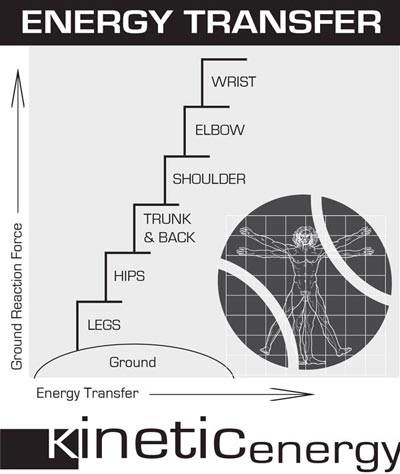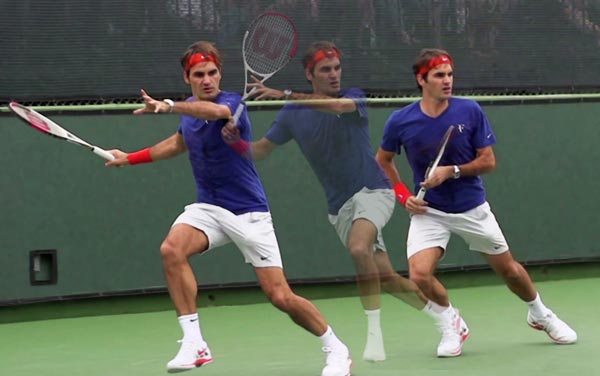| TennisOne Lessons Kinetic Energy and the Snowball Effect Coach Dan McCain
“Your life is a reflection of how effectively you balance potential and kinetic energy.”Dr. Steve Maraboli (Best-selling author and behavioral science academic) There are over twenty-five million bubbles waiting to burst out of each bottle of champagne. If you have never sent a cork flying up to your ceiling or out into the heavens, shake up a bottle of bubbly and give it a go. The carbon dioxide gases swirling around the yeast and fermented grapes create tremendous pressure and energy, which contributes to the formation of bubbles inside the bottle. All of that pressure and energy is released when the bottle is uncorked, which causes the cork to fly up and out of the bottle when opened.
But in a sport as fast paced and technical as tennis, how the tennis gods of today access that energy and release it into the ball is what makes them so powerful and effortless. Many mortals play the game with tremendous physical attributes but fail to generate the kind of effortless power the tennis gods do on a regular basis. How the tennis gods generate and utilize the potential and kinetic energy flowing through their bodies has become a model for mortals to copy. The methods that the LTA proposed to its coaches in the UK decades ago with the BIOMEC Model (mentioned in my previous Tennis One article (How the Tennis Gods Move) can serve players and coaches in enhancing the quickness and fluidity of one’s movement. The final letter of the BIOMEC acronym stands for the Coordination Chain, also known as the Kinetic Chain. This simply describes how the tennis gods build increasing amounts of energy up through their lower and upper bodies before releasing it into the ball. Just as a snowball rolling downhill grows in size as it picks up more snow from the ground, the tennis gods generate increasing amounts of energy traveling up through their bodies during stroke production.
Sound movement preparation has become an obsessive habit of the tennis gods to generate balanced, explosive first steps to each shot. The purposeful use of ground reaction forces, momentum, and the stretch and spring of major muscle groups dramatically enhance power generation and reduce workloads on joints. When these actions occur with the right timing and sequencing, the coordination chain functions at its finest. Regarding the ideal transfer of kinetic energy in tennis players, Jack Groppel wrote the following: “…the segments of the body act as a system of chain links, whereby the force generated by one link, or body part, is transferred in succession to the next link.” Groppel, an internationally recognized author and sport scientist, co-founded the Human Performance Institute. “The Kinetic Chain is defined as the coordinated activation of the segments of the body (legs, trunk, shoulder, arm, hand), transferring force efficiently from the ground to the racquet and ultimately to the ball. Each successive body segment transfers more energy than the previous one, resulting in maximal racquet acceleration.”
In his Feb 2009 article “The 4000-watt Tennis Player: Power Development for Tennis” (in the journal Medicine and Science in Tennis), W. Ben Kibler MD said this about the kinetic chain: “Athletes integrate patterned coordination of muscle activations, coordinated generation and control of forces, and sequencing of joint position and motions to produce power and skillful athletic activities involving the shoulder and elbow in tennis strokes.“ Kibler continued: “Power generation in tennis requires balancing the generation of forces and motions necessary to move the body, especially the shoulder and elbow, and propel the racquet and the control of these forces and motions for precision of performance and protection of the joints from excessive loading. The body achieves this balance by integrating the physiological muscle activations and the resulting biomechanical forces and motions throughout all the segments or links of the kinetic chain.”
The energy increases as it travels up through each link in the kinetic chain, creating a snowball effect. As each link uncoils, the tennis gods spring into the ball, thrusting substantial kinetic energy up through their legs, hips, trunk, shoulders, elbows, wrists, and finally their racquet heads. On July 3 2005, Roger Federer won Wimbledon for a third consecutive year, defeating Andy Roddick, 6-2, 7-6 (2), 6-4 in the finals. In an entertaining post-match press conference, Roddick described what transpired. ”I feel like I played decent, the statistics are decent and I got straight-setted. But I am not going to sit around and sulk and cry. I did everything I could. I tried playing different ways. I tried going to his forehand and coming in. He passed me. I tried to go to his backhand and coming in. He passed me. Tried staying back, he figured out a way to pass me, even though I was at the baseline. Hope he gets bored or something.” During this match at Wimbledon as well as many others against Federer, Andy Roddick fell victim to a more highly skilled player. Federer’s movement and ability to transfer tremendous energy into his shots in such a fluid, effortless manner showed far superior to the American’s biomechanics. On his personal feelings for Federer, Roddick continued: "I have loads of respect for him as a person. I've told him before, 'I'd love to hate you, but you're really nice’.” The Swiss Maestro’s movement has changed the game, with coaches worldwide and even his fellow tennis gods studying his movement. The way Federer glides around the court with such ease, efficiency and speed has given the sport an effortless and explosive model for us all to study and copy. It’s almost like he’s flying out there… When he sees his opponent’s racquet head moving forward to strike the ball, Federer begins his split step on this forehand below. Because of his vision before and during the stroke of his opponent, Federer is a master at anticipating his opponent’s shot. His ability to often predict not only the quality of his opponent’s shot but also the direction of where it’s soon to be going often gives him a head start in moving to the ball. This hidden factor separates him from the other players.
Because his eyes focus in on his opponent’s movement, preparation and racquet head action through contact, he can recognize what effect his opponent’s shot will have on him. He can see the speed and spin of the ball often before it has been hit. As a result, he has an instinctive sense about not only where it will bounce - but also where he needs to move in order to position himself optimally to respond. This is how he is able to perform a gravity step, which springs him toward this shot with a quick first step. As he elevates off the court to create the split step, he opens his right foot slightly when he sees that the ball will go to his right. He staggers the landing of his feet on his split step as they touch the ground. After landing on his left foot slightly before his right foot hits the ground, he shifts his weight onto his right leg and pushes his right leg into the ground. This generates a crossover step with his left leg and begins the quick, fluid lateral movement to his right. This makes for a quick move toward his forehand. During this smooth yet explosive movement preparation, Federer generates energy in his legs as he gains momentum toward the ball. He will soon use this energy and much more when he strikes his forehand.
Arriving to his shot, he steps heel-to-toe step with his right foot while striding into an open stance. Federer does this to maintain dynamic balance, as the heel-to-toe foot strike helps him slow the acceleration of his body and position himself for the shot. When the right leg lands this way, he loads his body weight onto it, pressing his right leg into the ground. His bent right knee coils the muscle groups in his legs and prepares him to execute the kinetic chain of his stroke.
As his momentum continues moving horizontally across the court, he uses the loading of his legs and ground reaction force to spring his energy upward into his shot. His legs springing up begin a succession of energy transfer that travel up through successive parts of his body. From the legs, through the hips, core and torso, and finally through the arm and wrist, the 17-time major champion transfers this powerful energy into the ball with his racquet head. Federer’s forehand will easily go down in history as one of the most dominant strokes the game has ever seen. A primary factor in his ability to generate amazing racquet head speed, the Swiss Maestro’s efficient energy transfer grants him the ability to produce powerful, effortless shots. The transfer of energy he uses from the ground up gives him the enhanced ability to strike his forehand in a range of situations with fluidity and strength, while simultaneously reducing the workload on the joints in his limbs. This has helped him remain relatively injury free throughout his career. * * * * * Your comments are welcome. Let us know what you think about Dan McCain's article by emailing us here at TennisOne .
Daniel McCain Daniel McCain serves as the Director of Tennis at the Cavalier Golf and Yacht Club in Virginia Beach and also as Tester for the PTR. McCain formerly served the USTA as the Manager of Player Development after 7 years of coaching Division 1 NCAA college tennis. He also served as the Director of Tennis at the Higueras-Gorin Tennis Academy and traveled with numerous players on both the WTA and ATP Tours. He is the author of Building a Champion, The I Formation, and Momentum and the 2015 released book How the Tennis Gods Move. This article by Daniel McCain, is based off of a chapter in the 2015 released book How the Tennis Gods Move, which is available on Amazon. |
 The bodies of the tennis gods also possess, as we all do, tremendous pressure and energy. Yes, their on and off court court fitness training molds their often Herculean physiques. Yes, their diets are often gluten free and sugar free and free of most things that taste good so they can build lean muscle. Yes, they are also born with incredible athletic ability.
The bodies of the tennis gods also possess, as we all do, tremendous pressure and energy. Yes, their on and off court court fitness training molds their often Herculean physiques. Yes, their diets are often gluten free and sugar free and free of most things that taste good so they can build lean muscle. Yes, they are also born with incredible athletic ability. 

 From the ground up, the tennis gods of today transfer massive amounts of energy from their bodies in motion into their shots. Through the energy generated during movement preparation for ground strokes, and also by coiling their upper and lower bodies in a coordinated sequence upon setting up for their shots, they create significant potential (elastic) energy. With the right timing and sequential uncoiling, the tennis gods can then use that potential energy and turn it into kinetic energy as it travels from the ground up through their bodies.
From the ground up, the tennis gods of today transfer massive amounts of energy from their bodies in motion into their shots. Through the energy generated during movement preparation for ground strokes, and also by coiling their upper and lower bodies in a coordinated sequence upon setting up for their shots, they create significant potential (elastic) energy. With the right timing and sequential uncoiling, the tennis gods can then use that potential energy and turn it into kinetic energy as it travels from the ground up through their bodies. 